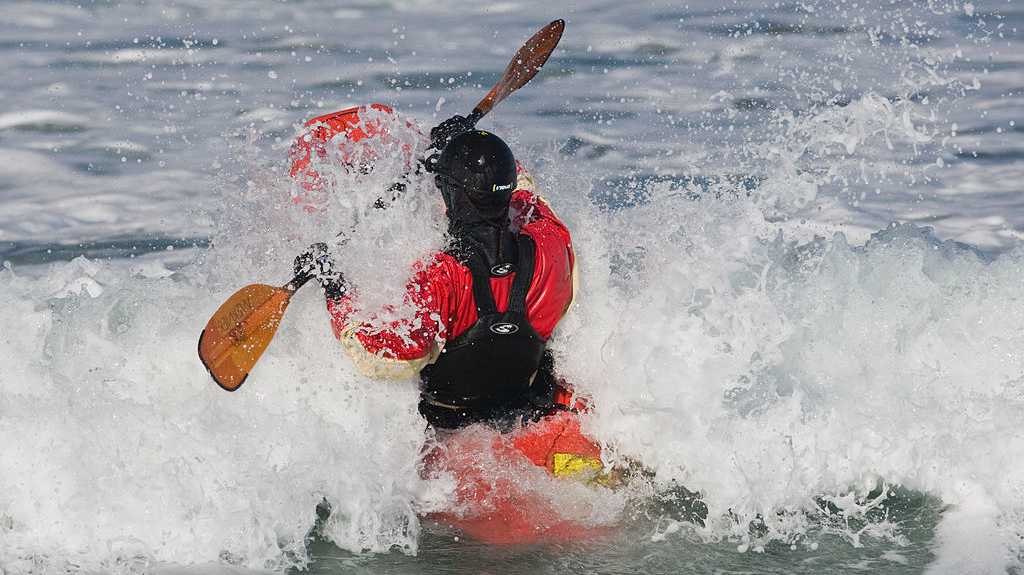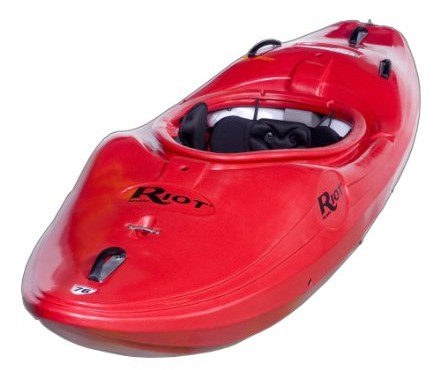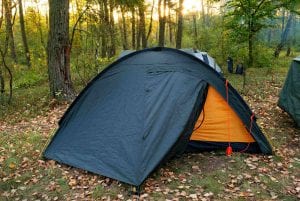
The sport of surf kayaking has, in recent years, become more and more popular. It combines the best bits of both disciplines — the adrenaline rush of surfing, partnered up with the manoeuvrability and stability of a kayak.
There are lots of factors to consider when picking your surf kayak:
- Do you want a dedicated surf kayak, or do you want a crossover boat that you can also use for other forms of kayaking (like river-running, flat-water cruising, playboating, or even kayak fishing)?
- Do you want a “closed cockpit” or a “sit-on-top” kayak? Closed cockpits are easier to control in rough water but you need extra skills in the event of a capsize.
- What’s your budget? Performance kayaks will cost you big bucks, but there are some fantastic value alternatives that are great fun in the surf.
Kayak design changes all the time, and, oftentimes, review sites feature out-of-date guides for models that aren’t available anymore.
Our buyer’s guide features a range of surf kayaks at various price points, all of which are available in 2021.
Riot Thunder 65 & 76

Specs
The Riot Thunder is a closed-cockpit white-water kayak designed for river-running. It’s got a relatively long (8’) waterline, and a semi-planing hull with a low cockpit that makes it easier to roll if you get dunked. The Thunder uses Riot’s Unity seating system, featuring a floating backrest, thigh braces, and adjustable foot braces. ($$$)
The Riot Thunder comes in a 65-gallon model, or a larger 76-gallon version for bigger paddlers.
The Verdict
If you’re looking for a responsive, closed-cockpit boat that’ll handle well in big waves, the Riot Thunder might just be the one for you.
A primarily fast but forgiving river-runner, its semi-planing hull helps it fly down the wave face while its slightly longer waterline makes it easier for you to push through the surf on your way out.
Experienced kayakers like to talk about boats you “wear” rather than just sit inside, and the Thunder is definitely in this category. The adjustable fit and thigh braces help you use your bodyweight and edges to grip the wave and ride across it — rather than overtake it and run out into the foam.
The only thing to bear in mind is that closed-cockpit kayaks can be more difficult to handle if you capsize. At the very least, you need to be able to successfully pop your spraydeck and safely exit the boat. Ideally, it’s best to be able to Eskimo roll.
In Summary
If you’re comfortable with closed-cockpit kayaks, the Riot Thunder is a great choice. It’s fast and responsive, and you’re able to take it on the river as well as in the surf.
If you’re nervous about the safety aspects of a tight-fitting kayak with a spraydeck, you might want to try one of the sit-on-top kayaks on this list, such as the Feelfree Nomad or Pyranha Surfjet.
Dagger Axiom

Specs
The Dagger Axiom is a fast white-water kayak with hard, full-length rails and a planing hull. Slimmer than a river-runner and longer than most playboats, it’s got a continuous rocker profile that’ll help you catch a variety of waves.
The Axiom is a closed-cockpit design for use with a sprayskirt. Inside, it’s a tight-fitting and highly adjustable kayak with a comfortable seat pad. Backrest, thigh braces, and foot braces can all be altered for the perfect fit, and you can also fit optional hip pads. ($$$)
The Dagger Axiom comes in three sizes for different paddlers — 8.0, 8.5, and 9.0.
The Verdict
One look at that planing hull and those lovely sharp rails and you know the Dagger Axiom is going to be something special in the surf.
Though it’s designed for rivers, it’s somewhere in that sweet spot between a river-runner and a playboat — that extra bit of length lets you carve beautifully across the wave face when you’re out on the sea.
Inside, the adjustable backrest, foot, and thigh braces mean the Axiom fits like a glove, letting you really drive with your legs and hips and making for a fantastically responsive ride.
It’s slightly odd that it doesn’t come with hip pads, as standard, since pretty much everyone will want them, but they’re available separately and are easy to fit.
The Axiom is the perfect boat if you’re an intermediate paddler who’s comfortable in bigger boats and ready to tackle something sportier.
If there’s one downside to it, though, it’s that the closed-cockpit design needs an extra set of skills to handle safely. You’ll need to be able to perform a “wet exit” in the event of a capsize, and you should be able to do a roll — all potentially while being chewed up in the surf.
However, if the thought of this sounds daunting, you might want to consider a sit-on-top surf kayak, which is still a lot of fun while being easier to recover.
In Summary
If you’re looking for an exciting river-runner that can carve across the surf with the best of them, the Dagger Axiom is a fantastic choice. It’s unusually forgiving for a performance boat and would be a great pick for an intermediate paddler looking to up their game.
If you’re wanting a kayak to paddle long days through flatter water on, or a kayak to fish off of, then you’re better off picking a sit-on-top like the Feelfree Nomad.
But for high-adrenaline rides on foamy waters, the Axiom is the one for you.
Jackson Rockstar 4.0

Specs
The shortest boat on this list — sitting between 5’7” and 6’1” — is the Jackson Rockstar 4.0. A closed-cockpit playboat in a lightweight plastic, it’s higher-volume than many other playboats, with a relatively soft drop-chine and a narrow hull. ($$$)
The Jackson Rockstar 4.0 comes in small, medium or large sizes for paddlers up to 250 lbs.
The Verdict
If you’re after a nimble little kayak that’s great for showing off tricks but also holds its own in the surf, the Jackson Rockstar is a solid bet.
Smaller playboats are normally deliberately tippy so you can pull off tricks and play moves, but the Jackson Rockstar is a deceptively buoyant kayak that sits relatively high in the water and feels much more stable than its length.
The higher volume and narrower hull also mean less drag, which translates into a faster downstream ride.
That said, the short length and tight fit make it incredibly maneuverable, and the dropped chine gives you a relatively soft edge — one that helps you carve across a wave while staying less likely to catch when you turn.
However, if you’re looking to paddle it on flat water, the Jackson Rockstar probably isn’t the best option. Though it’s large by playboat standards, it’s designed for showing off tricks and running fast with the water, and is too short to track and balance well in calmer conditions.
In Summary
The Jackson Rockstar 4.0 is a rare find — a playboat for pulling tricks that’s also a decent surf kayak. If you’re looking for a boat that does both of these things, this could be the one.
However, it’s not an all-rounder, and if you’re wanting a surf kayak that doubles as a more easy-going recreational kayak for flatter water, you might want to consider some of the others on this list — especially the sit-on-tops below.
Feelfree Nomad

Specs
The Feelfree Nomad is a multi-purpose sit-on-top kayak at a modest price point.
At 9’6″ it offers plenty of storage, including a rear deck and a rubber hatch, with molded handles and a stern wheel for easy transport. There are four molded footrests for people of different heights, and it comes with a padded seat.
Feelfree also makes a range of optional extras for the Nomad, including a rear skeg (fin) and thigh straps. ($$)
The Verdict
If you’re looking for an all-rounder on a budget, the FeelFree Nomad is a top pick. It’s a blast in the surf — especially if you install the optional thigh straps to give you better grip.
It’s a forgiving, no-fuss boat that’s built to give you hours of fun on the beach, whether you’re cruising flat water, doing some fishing, or carving up the surf.
The downside to the Nomad is that it doesn’t track all that well if you’re paddling it on flat water. But, fortunately, you can improve this greatly by installing the optional rear skeg.
In Summary
If you’re in the market for a wallet-friendly sit-on-top that’s equally good for at home surfing, fishing, or cruising, the Feelfree Nomad is a great choice.
It doesn’t have the performance of some of the other surf kayaks on this list, but it’s a fantastic all-rounder, and you can install optional upgrades depending on what you want to use it for.
Pyranha Surfjet 2.0

Specs
The Pyranha Surfjet 2.0 is an inexpensive sit-on-top kayak that can be configured for touring or surfing, depending on which accessories you bolt on.
For surfing, Pyranha sells an optional backstrap and thigh straps, and there’s also a screw-in mount for an action camera. At 8’8″ long, it’s compact, stackable, and designed to be stored upright in a garage.
The semi-planing hull has a raised bow and a triple keel at the stern. Four molded footrests accommodate different-sized paddlers, and there’s a flat swimming platform at the back. The Surfjet is lightweight, with comfortable carry handles at the cockpit and also at the bow that can be combined with an optional portage wheel in the stern for easy wheeling. ($)
The Verdict
If you want a kayak that you can use to play in the surf but that’s also a respectable flat-water cruiser, the Pyranha Surfjet 2.0 could be the one for you — especially at such a low price.
It’s easily configured with a comfy seat and rod holders for recreational paddling or fishing, but with thigh braces and backstrap it becomes a super-fun surfing boat. The unusual hull design with the rear tri-keel helps you maneuver on a wave, and for a relatively short boat it also tracks very well in flatter water.
It’s also refreshing to find a kayak manufacturer who’s really thought long and hard about storage and transport. The Surfjet can be stored upright to maximize your garage space. And, if you’re a couple or a family, you can get more than one and stack them inside each other. Plus, fit a stern wheel and the front handles will make it easy to trolley about.
If you’re a beginner surfer, the Surfjet’s sit-on-top cockpit and sloping rear platform mean it’s easy to sort yourself out after a capsize. And you’ll want to use the screw-in GoPro mount on the front to capture all the thrills and spills.
In Summary
If you’ve only got space for one boat and want to cover a lot of bases, the Pyranha Surfjet 2.0 is a great pick.
With a couple of optional extras fitted, it’s loads of fun in the surf. But you can also configure it for lazy days out cruising or fishing on flat water.
It feels safe and easy to remount in the surf, and would suit beginner or intermediate paddlers who don’t feel confident in a closed cockpit.
How to Choose a Surf Kayak
There are a whole load of different factors to consider when you’re buying a surf kayak.
Length
A longer kayak usually tracks better — meaning it’s easier to paddle in a straight line — and tends to be faster on flatter water.
The downside is that they can be harder to turn and more difficult to handle in white water.
In the surf, it’s quite tricky to stop a longer kayak getting spun across the waves and flipped. Hence why paddlers in 16’ sea touring kayaks are understandably nervous of the surf zone.
For this reason, surf kayaks are generally on the shorter side, though you might see some specialist surfing kayaks that combine a slightly longer length with hard rails — rather like a longboard.
Typically, most surfing kayaks are between 7’ and 9’. Longer than 10’ and it’ll start getting harder to control, while kayaks below about 6’ have such a short waterline that they don’t carve very well.
As with surfboards, shorter surf kayaks are more responsive while longer ones are more stable and forgiving. If you’re looking for a recreational kayak that’s good for both surfing and open-water paddling, something around 9’ or 10’ is a good compromise.
Hull shape
There are endless hull shapes for kayaks, each with different pros and cons. Common variants include rounded, v-shaped, or flat hulls, and many manufacturers will blend different shapes depending on the boat’s intended use.
Surf kayaks will usually have “planing hulls” which are flat bottoms that allow them to “plane”, or skim, across the top of the water when they’re going fast.
A dedicated surf kayak might also have fins like a surfboard, or a single “skeg” like a windsurfer.
If you’re buying a multi-use kayak with surfing in mind, you probably won’t want a pure planing hull because they’re slow on the flat and difficult to paddle in a straight line.
You’ll be looking to compromise with a hull that has some shape to it but that doesn’t feature too much displacement. Deeply rounded or v-shaped hulls with a lot of surface area underwater will track beautifully on calm waters, but they create so much drag that you’ll struggle to catch a wave.
Chine/Rails
The chine is how the bottom of the kayak connects with the sides. “Hard” chine means that there are more defined edges, while “soft” chine is a smoother curve.
In the context of surf kayaks, hard chines give you an edge that you can use to carve tight turns as you’re surfing. The flipside (quite literally) is that they make the kayak less forgiving in chop so you’re more likely to go over.
Because surf kayaking is somewhere between the two sports, it sometimes borrows terminology from boards rather than boats. When surf kayakers talk about “rails,” they’re really talking about chines.
It’s just another way of describing that hard edge that you can use to dig into waves to slice across rather than skid down.
Rocker
“Rocker” is the curve between the bow (front) and stern (back) of the kayak. More rocker generally means more drag, so the boat will be slower. However, the more defined pivot point also makes it more maneuverable.
This is where surf kayaking is a bit different to other forms of white-water paddling.
Generally, a surf kayaker on bigger waves is planing (skimming the water) and using their edges to turn. To start planing, you need to reach a certain speed, which is more difficult on a slower hull with more rocker. However, a surf kayaker also needs their boat to sweep up at the front, otherwise the nose might dig in and then it’s game over.
Thus, performance surf kayaks have a decent amount of rocker at the front and little or none at the back.
Volume
Volume is more than just how much you can fit in a boat. It also affects buoyancy, which in turn can have knock-on effects on stability, speed, and maneuverability.
A boat that sits lower in the water may be slower but more stable, and cruising kayaks that are designed to pony about a lot of gear may feel tippy if they haven’t got enough weight in them.
At the other end of the scale, a small boat with a heavy paddler in it may sit too low in the water, making it slow and easily swamped.
Manufacturers will tailor the buoyancy to a kayak’s intended use, but it’s important you pick a boat that’s designed for someone your size. Popular models will often be made in a range of volumes for different paddlers.
Cockpit
There are various cockpit designs, but, broadly, kayaks are either closed-cockpit or sit-on-top.
Closed-cockpit kayaks are where you sit inside the body. They’re usually used with a “spraydeck” (or “sprayskirt”) which is secured around the hatch to keep water out. These are generally more maneuverable, as you sit lower in the water and you can use your legs and hips to control the boat much more effectively.
The difficulty, of course, is if you capsize. Unless you’re skilled enough to perform the famous “Eskimo roll”, you’ll have to perform a wet exit by popping your spraydeck and pushing out of the boat. When you turn the kayak the right way up again, it’ll fill with water and will be difficult to control unless you can empty it out.
Sit-on-tops are easier to self-rescue, but often harder to control in the surf. For this reason, dedicated surf kayaks are usually closed-cockpit boats. For more casual surf kayaking, however, there are some great sit-on-top options, especially if you add thigh straps for extra control.
Specialist Surf Kayaks
Specially engineered surf kayaks have a very distinctive design, but, because it’s still a growing sport, very few retailers will stock them.
If you do want a dedicated surf kayak, you’ll normally need to order it directly from a manufacturer such as Mega, Watertech, Ride, or Murky Water.
Waveskis
Not to be confused with a surfski (which is a long, slim racing kayak), a waveski is a cross between a surfboard and a kayak, and is designed specifically for surfing.
You sit on top of it rather than inside it, use a paddle, and grip the board by means of foot straps like a windsurfer does.
Waveskis are still a very niche product, so they’re usually a custom order that you’ll need to source directly from the manufacturer. Top brands include Island, Infinity, MacSki, and Wavemaster.
Combination Boats
Given the cost of a kayak, you’ll probably be tempted to go for a boat that does more than one thing.
Many white-water kayaks do well in the surf too, and even some recreational kayaks can handle waves well if they’ve got the right characteristics.
Getting a combination boat gives you a much bigger pool of kayaks to choose from, and also means you can enjoy a wider range of activities.
*Image Credit: Mike” Michael L. Baird, CC BY 2.0 https://creativecommons.org/licenses/by/2.0, via Wikimedia Commons






